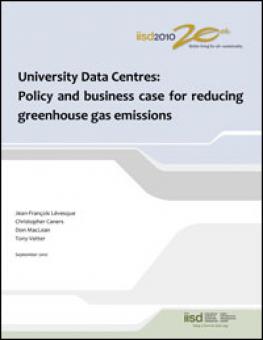
University Data Centres: Policy and business case for reducing greenhouse gas emissions
In this study, IISD assesses the feasibility of reducing greenhouse gas emissions and generating carbon offsets via the relocation or modification of University Information and Communication Technology (ICT) assets, leveraging Canada's Advanced Research and Innovation Network's (CANARIE's) fibre optic network that connects universities across Canada.
Working with three universities, IISD prepared carbon footprint analyses and explored the business case for relocation that access to carbon credits might support. Several options are presented, including a proposal to co-locate or consolidate multiple data centres, allowing them to be optimized and operated more efficiently and effectively through virtualization, best practices and economies of scale, ideally in a green community cloud configuration.
In particular, the study investigated three scenarios: (1) moving University data centres to remote, zero-carbon (i.e., powered with renewable energy) facilities; (2) relocating the data centres to urban settings in provinces with low-emission electrical grids and where waste heat from the data centre can be utilized effectively; and (3) modifying the existing data centre to capture and utilize waste heat. Upon analyzing these scenarios, it was determined that only the third, in one case, would generate sufficient revenue from the sale of carbon credits to overcome the expense of the project.
Following the principles of ISO 14064-1 to the extent possible, the carbon footprint for the main data centres at each University was completed. To limit the complexity of this study, only the main ICT data centres designed and operated to host each University's mission-critical systems were evaluated. The annual carbon footprint ensuing from the operation of all three data centres combined was 11,305 tonnes of carbon dioxide equivalent (CO2e)—Ottawa, 1,007; Dalhousie, 5,010; and Alberta, 5,288.
Based on the carbon footprint analysis, the revenue from the sale of carbon credits (or offsets) and the incremental costs associated with the implementation of each scenario were estimated for each University and a net present value (NPV) calculated. The NPV was not positive for any of the Universities under the first or second scenarios; only the analysis for the University of Alberta resulted in a positive NPV in the third scenario.
Ultimately, the investigation found that although the economics for generating revenue via carbon credits from data centres was generally not attractive for the individual Universities studied, a green community cloud data centre operated and administered by CANARIE has numerous other benefits and is more likely to be economically beneficial, presenting a perhaps ideal opportunity for CANARIE to leverage its position and provide leadership to its membership and the Canadian ICT sector in general.
Policy implications and opportunities are presented for federal and provincial governments, universities, data centres and CANARIE.
You might also be interested in
The Critical Next Step: What you need to know about Canada’s 2030 climate target
Canada's climate target for 2030 is within reach, but more stringent policies and clearer government communication will be needed to get there. Our expert explains why these developments are critical for Canada to help avoid the worst impacts of climate change.
Ottawa supports Big Oil over the climate
One can only imagine the positive buzz these days inside the boardrooms of Canada's oil companies, as they rake in record profits and plan major expansions of their oil production. Amid all the good cheer, one could easily lose sight of the fact that those plans will push the world dangerously closer to the brink of irreversible climate chaos. Even as the world finally signed a commitment at UN climate talks last month to begin transitioning away from fossil fuels, Canada's major oil companies are poised to do exactly the opposite — to greatly expand their fossil fuel production.
Feds and province veto offshore oil exploration in Nova Scotia
A licence to explore the offshore of Nova Scotia for oil and gas and restart fossil fuel activity there after years of dormancy was rejected Monday by the federal and provincial governments. The decision to reject the licence considers broader policy focused on "shared commitments to advance clean energy and pursue economic opportunities in the clean energy sector, which are beyond the scope of the board's regulatory purview," a joint statement said.
Canada won't get to net zero without an emissions cap on oil and gas, researchers say
The oil and gas sector is being increasingly scrutinized for its contribution to the climate crisis, as it is estimated that this particular industry is responsible for more than 75 per cent of global greenhouse gas emissions and nearly 90 per cent of all carbon dioxide emissions, according to the United Nations. While many producers have said they are committed to the global goal of net-zero emissions by 2050, with production of oil and gas expected to continue to ramp up for the foreseeable future, it’s difficult to see how this will be achieved.